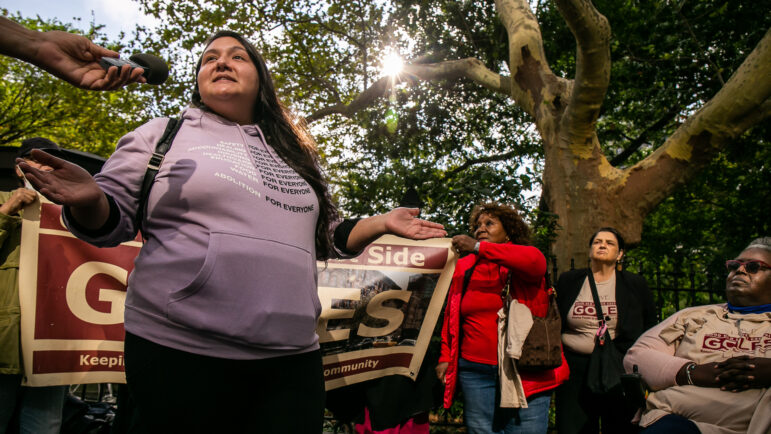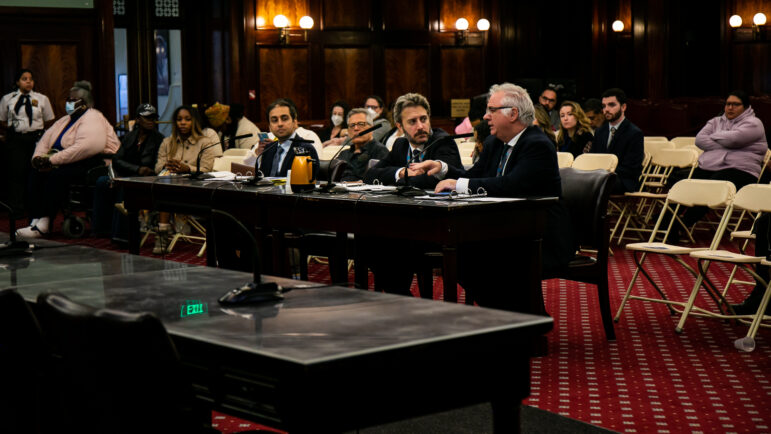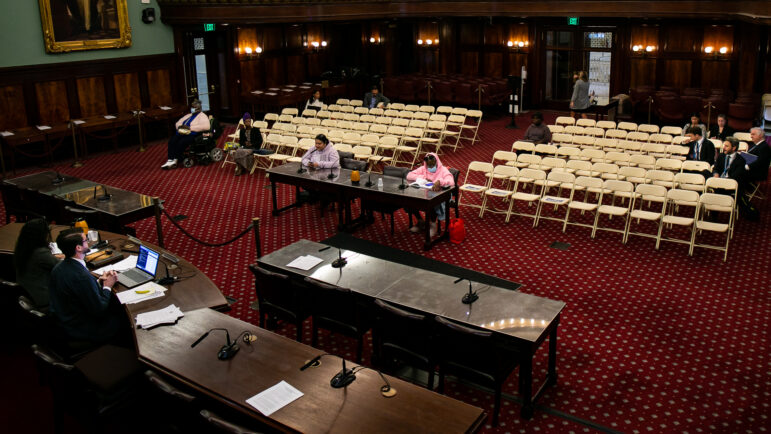This year’s Physical Needs Assessment showed a 73 percent leap from the last report in 2017—a staggering change NYCHA has attributed in part to inflation and construction costs.

Christina Chaise, a tenant at the Ravenswood Houses in Queens, was eager to testify at Friday’s City Council hearing.
She arrived at City Hall 45 minutes early, before NYCHA representatives took the hot seat to address the housing authority’s Physical Needs Assessment (PNA).
NYCHA has been using the PNA to examine the conditions of public housing developments across the city at regular intervals since 2006. Some of the factors considered include apartment conditions such as piping, operational systems like elevators, exterior areas such as playgrounds and sidewalks, and electrical systems like fire alarms and security cameras.
These reports, according to NYCHA, are a vital tool used to gauge the needs of properties and plan capital projects. The result comes in the form of an estimated cost. Short-term repairs take one to five years to complete, while midterm repairs take between six and 20 years.
In the past, the PNA represented all NYCHA developments—excluding those converted to private management—each projecting a hefty bill for both short and midterm needs.
This year’s PNA, however, only used a fraction of developments for the assessment. And yet, it showed a 73 percent leap from the last report in 2017 to $78.3 billion—a staggering change NYCHA has attributed in part to inflation and construction costs.
In written testimony, NYCHA’s Chief Asset and Capital Management Officer Shaan Mavani said that because the 2017 PNA gathered “so much baseline information,” the 2023 PNA only focused on 30 NYCHA properties, or roughly 29,000 apartments. Going forward, it will be updated annually, he added.
“This was done through surveys and interviews of property staff and resident leaders at these sites, joint walkthroughs, and architectural and engineering assessments in all buildings—10 to 15 percent of apartments in each property—and the grounds,” according to Mavani.
During questioning by Brooklyn Councilmember and Public Housing Committee Chair Alexa Aviles, he added that the PNA is a planning tool, and “is not a replacement for cost estimating and other activities we undertake when we actually have a project and budget.”
Indeed, a recent analysis by the news outlet THE CITY showed that actual repair costs come in below PNA estimates.
The PNA has raised doubts among tenants, who question if it is an accurate reflection of NYCHA’s needs—especially with figures such as $485,000 to repair the average unit.
Some have raised an eyebrow at the price tag, wondering if it is a talking point to encourage transferring properties to private entities through the Permanent Affordability Commitment Together (PACT) program or the newer Public Housing Preservation Trust.
“We should not have to sacrifice our Section 9 lease to get the repairs that we deserve; that we needed for decades,” Chaise, the second vice president of her complex’s tenant association, said at a rally ahead of the hearing. “It’s an investment in our city at large and our workers and our families.”

Mavani of NYCHA testified Friday that approximately $38 billion, or 49 percent of the 20-year PNA estimate, can be addressed through ongoing planned capital projects, the PACT program and the Preservation Trust.
“In cooperation with our partners, we need to fully rehabilitate an additional 47,000 apartments through PACT, and the Public Housing Preservation Trust currently allows for comprehensive renovation of 25,000 apartments,” Mavani said.
But some advocates focused on smaller-scale needs on Friday—needs they say get swallowed up by PNA discussions.
“Every day in housing court, NYCHA attorneys point to the PNA as an excuse for why they won’t do repairs at our clients’ apartments, even when those repairs are as simple as fixing a sink or patching a wall so that there’s no exposed wiring,” Anna Luft, Project Director for the Public Housing Justice Project at the New York Legal Assistance Group (NYLAG), said at the rally.
“We are here today to demand that NYCHA meet its immediate obligations to its residents while simultaneously seeking additional funding—no exceptions,” she continued.
Inside the hearing, Aixa Torres, the tenant association president at the Alfred E. Smith Houses in Lower Manhattan and member of the Citywide Council of Presidents (CCOP), was among the first to speak.
As Torres put it, “Some of the fixes are so simple that it is beyond ridiculous.”
During her testimony, Torres suggested that the PNA assessment be done over again, next time as a “dual venture” with residents and management walking through the buildings together to have a more fine-tuned idea of what the needs are.
“We know exactly what we need,” Torres said.
Sophie Cohen, a staff attorney at NYLAG, testified that the PNA is not an excuse for repairs to be left undone—especially the simpler ones. Cohen shared an example of a client whose mailbox lock has been broken for months.
“This means that her legal and personal mail has been left unsecured and even though the mailbox can be fixed with a single screw, NYCHA has refused, telling her that she has to wait until they have all the money to replace all the mailboxes in the entire development,” Cohen said.

Short-term fixes—those estimated to take between one and five years to complete—make up about 77 percent, or $60.3 billion, of the entire PNA estimate, according to NYCHA.
Brooklyn Councilmember Chi Osse implored that the authority respond to the mounting repair needs with a sense of urgency.
“What is the total cost that it would take for us to not have to have these hearings and, excuse my language, but bitch back and forth to the agency about what needs to be done to repair NYCHA as a whole?” Osse asked.
Mavani explained that the PNA, in part, is the answer to that question.
NYCHA’s Senior Vice President of Intergovernmental Affairs, Brian Honan, chimed in to the exchange, saying that infrastructure costs are just part of a larger picture.
“Even if Shaan somehow gets a check when he gets back to the office and there’s a check waiting for him for $78 billion and he’s able to do that work quickly, we need to make sure we’re keeping up on the operations side so we’re able to maintain that,” Honan said.
Rent payments fund one-third of NYCHA’s operating expenses. The latest figure in August showed that the housing authority only collected 62 percent of rent.
“When I first started at NYCHA [in 2006] we had 16,000 employees,” Honan said. “We’re down to about 12,000. And so when you take a hit like that, when I go to developments and I speak to staff, which is often, staff don’t tell me ‘I wish I had more vacation’ or ‘I wish I had a raise.’ I’m sure they would love that, but what they say is, ‘If you guys just give me two or three more people, I think we can—’”
“And what’s the price tag for that?” Osse interjected.
“We can come back to the Council on that,” Honan replied.
By the end of the more-than-three-hour hearing, the council chambers were nearly empty, as attendees and some NYCHA officials exited, including Mavani.
Without much of an audience, it was time for Chaise to state her testimony.
She shared her mistrust for the validity of the most recent PNA, saying residents want “real and accurate” data that directly correlates with the development they live in.
This is particularly important because NYCHA residents will be asked to consider the figure before voting on whether private developers should help fund their repairs, either through PACT or the Preservation Trust.
“NYCHA’s PNA holds more significance now more than ever before, because it is one of several materials residents will receive if and when it comes time to vote on the future of their homes,” Chaise said.
To reach the reporter behind this story, contact Tatyana@citylimits.flywheelstaging.com. To reach the editor, contact Emma@citylimits.flywheelstaging.com.









One thought on “NYCHA Faces Scrutiny For $78.3B Repairs Price Tag”
This is another step in the movement to privatize public property and assets. Note that most NYCHA properties were built in essentially abandoned spaces which now, with the reverse flow of capital, have greatly increase in value.